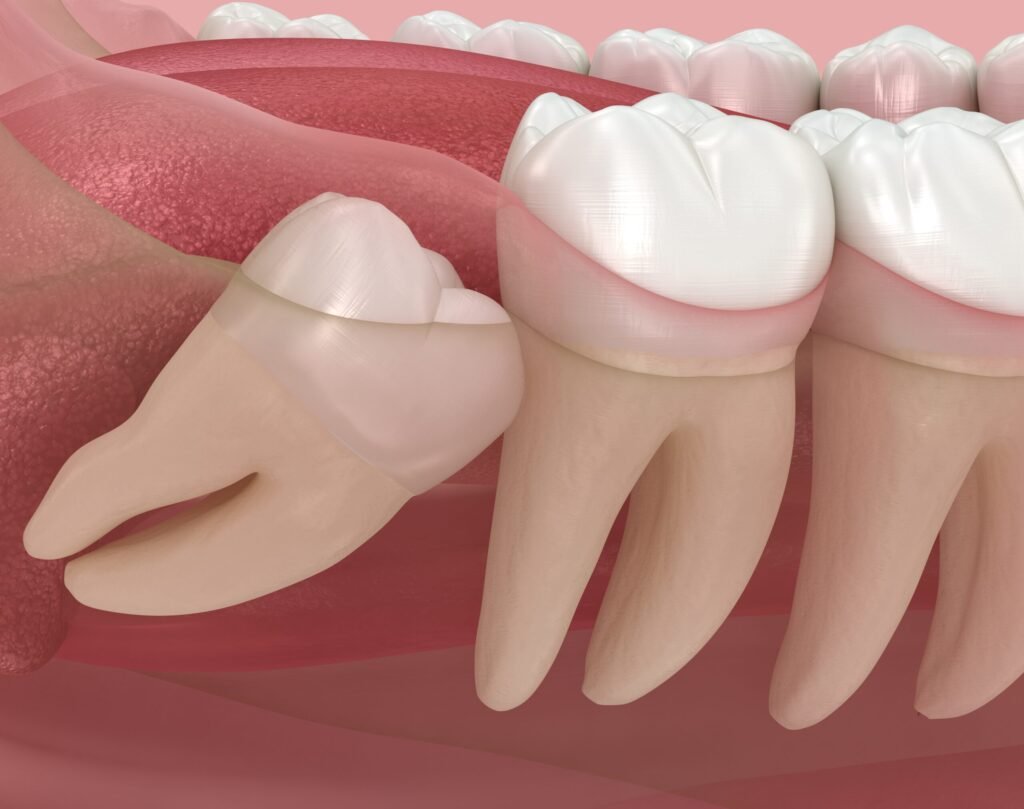When it comes to dental health, few topics spark as much conversation and concern as wisdom teeth. For generations, many people have commonly believed that these final molars are a ticking time bomb, destined to cause pain and problems for everyone. For that reason, many assume that wisdom teeth removal is an inevitable rite of passage. But is that really the truth? While wisdom teeth removal is a very common procedure, the fact is, it’s not always necessary. You make the final decision to remove them after a qualified dentist performs a careful assessment.
Understanding Your Wisdom Teeth
Wisdom teeth, or third molars, are the very last teeth to erupt in a person’s mouth. They typically make their appearance much later than other teeth, usually between the ages of 17 and 25, which is why they earned their name, coming in at a time when a person is supposedly “wiser.”
From an evolutionary standpoint, these teeth were a crucial part of our ancestors’ diet, which often consisted of tough, raw foods. A strong jaw and a full set of large molars were necessary to chew and grind these materials. However, as human diets and jaws have evolved over thousands of years, our jaws have become smaller. This change has led to a common problem, a lack of space for these final teeth to emerge properly. This is the root of most wisdom teeth issues.

The Problem with Impaction
The primary reason dentists recommend wisdom tooth extraction is impaction. This occurs when a tooth does not have enough room to break through the gums. Instead of erupting straight, the wisdom tooth can become stuck, or impacted, in the jawbone or gum tissue.
There are several types of impaction, each with its own set of potential problems:
- Vertical Impaction, the tooth is in the correct vertical position, but it is stuck against the tooth in front of it.
- Angular Impaction, the tooth is angled sideways, pushing against the molar in front of it. This can cause significant pain and damage to the neighboring tooth.
- Horizontal Impaction, the tooth is lying completely on its side, making it impossible to erupt and often causing it to push into the roots of the tooth next to it.
- Soft-tissue Impaction, the tooth has partially broken through the bone, but gum tissue covers it. This creates a flap of gum, called an operculum, that can easily trap food particles and bacteria, leading to a painful infection known as pericoronitis.
When It Is Truly Necessary to Remove Your Wisdom Teeth
The decision to remove a wisdom tooth is always based on a clinical evaluation. It’s not a one-size-fits-all situation. Your dentist will consider several factors, including pain, potential for future problems, and the overall health of your mouth.
Common reasons for extraction include:
- Pain and Discomfort: If a wisdom tooth is impacted or putting pressure on other teeth, it can cause constant throbbing pain, jaw stiffness, and swelling in the gums.
- Damage to Neighboring Teeth: An impacted or partially erupted wisdom tooth pushing against the adjacent molar can cause damage, leading to pain, fractures, and even tooth loss.
- Crowding and Misalignment: In some cases, the emerging wisdom teeth can shift other teeth, affecting your bite alignment and potentially undoing years of orthodontic work.
- Gum Disease and Cavities: The location of wisdom teeth at the very back of the mouth makes them notoriously difficult to clean effectively. Food particles and plaque can easily get trapped, leading to a higher risk of cavities and serious gum disease.
- Cysts or Tumors: While uncommon, a fluid-filled cyst can form around an impacted wisdom tooth. If left untreated, it can expand and hollow out the jawbone, causing significant damage to surrounding bone and nerve tissue.
When It Is Okay to Keep Your Wisdom Teeth
The good news is that not everyone needs to have their wisdom teeth removed. If a wisdom tooth is healthy, fully erupted, and positioned correctly without causing any problems, there is often no reason to remove it. Your dentist will recommend keeping your wisdom teeth if:
- They have grown in completely straight and are fully functional.
- You can clean them effectively with your normal oral hygiene routine, including flossing.
- They are not causing any pain, discomfort, or crowding of other teeth.
- There are no signs of gum disease, decay, or other pathology.
Your dentist will closely monitor these teeth with regular check-ups and X-rays to ensure they remain healthy over time.
Wisdom Teeth: To Remove or Not to Remove?
| Why Remove? | Why Keep? |
| Impacted: Not enough room to emerge, causing pain and infection. | Properly Erupted: Growing in straight and fully emerged. |
| Damaging Neighboring Teeth: Pushing against other molars, causing pain and fractures. | Healthy: No signs of decay or gum disease. |
| Causing Crowding: Shifting other teeth and affecting bite alignment. | No Symptoms: Not causing any pain, swelling, or discomfort. |
| Leading to Gum Disease/Cavities: Difficult to clean, leading to oral health issues. | Able to be Cleaned: You can reach and clean them effectively with normal oral hygiene. |
| Cysts/Tumors: Rare, but can develop and cause serious health problems. | Not Impeding Function: They do not interfere with your bite or chewing. |
Potential Problems Caused by Wisdom Teeth
| Problem | Description |
| Pain and Swelling | Caused by pressure from an impacted tooth or an infection in the gum tissue. |
| Tooth Damage | The pressure from an emerging wisdom tooth can cause fractures or cracks in adjacent molars. |
| Oral Infection | The difficult-to-clean area around a partially erupted wisdom tooth can trap bacteria, leading to infection. |
| Jaw Pain and Stiffness | Pressure from the wisdom tooth can cause discomfort in the jaw and surrounding muscles. |
| Misalignment of Teeth | A wisdom tooth pushing forward can cause other teeth to shift, leading to a crowded smile. |
What to Expect at a Wisdom Teeth Consultation
If your dentist suspects you may have a wisdom tooth issue, they will recommend a comprehensive consultation. This appointment is a crucial step in determining the best course of action.
During the consultation, your dentist will perform a thorough visual and clinical examination. They will also take a panoramic X-ray, which provides a detailed, two-dimensional view of your entire mouth, including all of your teeth, your jawbone, and the nerves in your face. This imaging is essential for seeing the position of your wisdom teeth, especially if they are impacted, and for identifying any potential risks or complications.
The dentist will discuss the findings with you, explain the reasons for their recommendation, and answer any questions you may have.
A Look at the Removal Procedure and Recovery
If you decide to proceed with wisdom teeth removal, the procedure is a straightforward one that dentists routinely perform. Your dentist or oral surgeon can use local anesthesia, sedation, or general anesthesia, depending on the complexity of the extraction and your comfort level.
After the wisdom teeth removal, a smooth recovery is key to preventing complications. Your dentist will provide detailed aftercare instructions to help manage pain and swelling. You will typically use a cold compress, stick to a diet of soft foods and liquids, and avoid strenuous activity for a few days. They will also advise you on how to keep the surgical site clean with gentle saltwater rinses.
Frequently Asked Questions
Wisdom teeth are the last set of molars to come in, usually between the ages of 17 and 25.
No, not everyone develops wisdom teeth. Some people may have one, two, three, or all four. Some people may not have any at all.
Not necessarily. If your wisdom teeth are growing in straight, are healthy, and you can clean them effectively, your dentist may recommend keeping them.
An impacted wisdom tooth is one that doesn’t have enough room to emerge properly and remains trapped within the jawbone or gum tissue.
Your dentist will perform a clinical examination and take X-rays to see the position of your wisdom teeth and assess their health.
Common signs include pain or swelling in the back of your mouth, jaw pain, a bad taste in your mouth, or a noticeable shift in your other teeth.
Your dentist will give you an anesthetic so you will not feel pain during the procedure itself. Your dentist or oral surgeon will provide specific instructions for managing any post-operative discomfort.
Yes, in some cases, the pressure from an emerging wisdom tooth can cause other teeth to shift, leading to crowding and misalignment.
A dry socket is a painful condition that can occur after tooth extraction if the blood clot that forms in the empty socket is dislodged.
Recovery time varies, but most people feel significantly better within a few days. Your dentist will provide detailed aftercare instructions to help ensure a smooth recovery.
Making a Confident Decision About Your Smile
Understanding the facts about wisdom teeth is the first step toward making a confident decision about your oral health. The truth is, there’s no single answer that applies to everyone. By staying informed and working with your dental team, you can determine if your wisdom teeth pose a risk or can be a healthy part of your smile. At Smiles by Eddie, we are committed to providing you with the highest quality care, whether that means monitoring your wisdom teeth or performing a safe and comfortable wisdom teeth removal.
Ready to find out if wisdom teeth removal is right for you? Contact us to book an appointment today. You can also get to know our team by visiting our Meet Dr. Ahdoot page or see the transformations we’ve created in our gallery.

